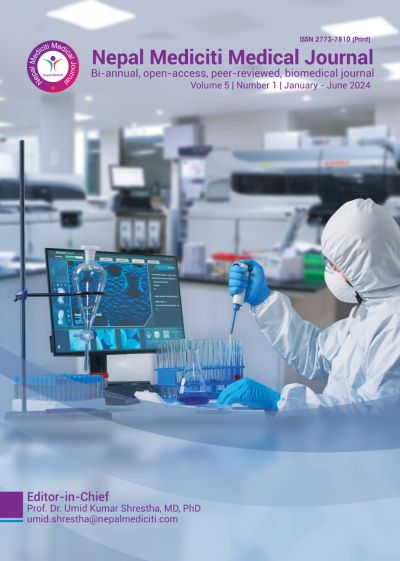Comparative study on efficacy of benzoyl peroxide with adapalene versus plain adapalene in the treatment of acne vulgaris
DOI:
https://doi.org/10.3126/nmmj.v5i1.68433Keywords:
Acne vulgaris, topical,, adapalene, benzoyl peroxide with adapalene, efficacyAbstract
BACKGROUND Acne vulgaris is a dermatological disorder of pilosebaceous unit, characterized by formation of comedones and inflammatory lesions. It is one of the most common skin manifestations among adolescents, also affecting the adult population. The treatment of acne basically involves reduction of lesions and prevention of permanent scarring. The current line of treatment for mild to moderate acne is topical medications with antimicrobials and retinoids. The present study assessed the efficacy of combination of adapalene and benzoyl peroxide in comparison to adapalene for topical treatment of mild to moderate acne vulgaris.
OBJECTIVE The purpose of the study was to compare the clinical efficacy of topical adapalene and topical adapalene with benzoyl peroxide in treatment of mild to moderate cases of acne vulgaris.
METHODOLOGY A prospective, comparative study was carried out among 84 patients with mild and moderate acne vulgaris visiting the Department of Dermatology, Kathmandu Medical College and Teaching Hospital, Bhaktapur, Nepal from December 2019 till March 2021. The patients fulfilling the inclusion criteria were divided into two groups. Group A received topical adapalene whereas Group B received topical adapalene with benzoyl peroxide. The efficacy of treatment in both groups were determined based on the reduction of total lesion count. Both inflammatory and non-inflammatory lesions were counted at 4th week, 8th week and 12th week.
RESULTS All patients were assessed according to Global Acne Grading System (GAGS) and grouped as mild and moderate. The most frequent age group affected by acne vulgaris was 18-22 years. The mean age was 22.15 ± 5.315. Females (64.30%) were affected more commonly than males (35.7%). Majority of patients presented with moderate or inflammatory acne lesions. The face (90.5%) was most commonly affected site by acne vulgaris. The number of patients enrolled in the study were 84 out of which 63 (75%) completed the study. It was found that the reduction of non-inflammatory, inflammatory and total lesion count from the baseline were highly significant in between and both the group (P<0.001). A total of 52.4% had very good result of the treatment, 44.4% of them had good result and remaining 3.2% of the patients’ result was fair. However, the efficacy of benzoyl peroxide with adapalene was found to be better than adapalene alone.
CONCLUSION
This study concluded that topical benzoyl peroxide with adapalene is more efficacious to treat mild to moderate acne vulgaris.
Downloads
Downloads
Published
How to Cite
Issue
Section
License

This work is licensed under a Creative Commons Attribution 4.0 International License.
This license enables reusers to distribute, remix, adapt, and build upon the material in any medium or format, so long as attribution is given to the creator. The license allows for commercial use.

